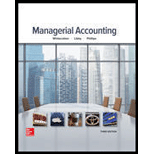
(a)
Introduction:
To indicate:
Whether the accounts receivable increased (I) or Decreased (D), using the given cash flow statement.
(b)
Introduction:
Cash flow from operating activities calculates the inflow and outflow of cash from day-to-day activities. It includes operating income and operating expenses for the year. It also includes changes in current assets and current liabilities as they lead to inflow/outflow of cash.
To indicate:
Whether the inventories increased (I) or Decreased (D), using the given cash flow statement.
(c)
Introduction:
Cash flow from operating activities calculates the inflow and outflow of cash from day-to-day activities. It includes operating income and operating expenses for the year. It also includes changes in current assets and current liabilities as they lead to inflow/outflow of cash.
To indicate:
Whether the Accounts payable increased (I) or Decreased (D), using the given cash flow statement.
Want to see the full answer?
Check out a sample textbook solution
Chapter 12 Solutions
Managerial Accounting
- I am trying to find the accurate solution to this general accounting problem with appropriate explanations.arrow_forwardI need help with this general accounting question using standard accounting techniques.arrow_forwardI am looking for a reliable way to solve this financial accounting problem using accurate principles.arrow_forward
- I need help with this general accounting problem using proper accounting guidelines.arrow_forwardPlease explain the solution to this general accounting problem using the correct accounting principles.arrow_forwardCan you help me solve this general accounting question using the correct accounting procedures?arrow_forward
- Horngren's Financial & Managerial Accounting: The Managerial Chapters, 8th Edition. E-M:9-14 Describing the balanced scorecard and identifying key performance indicators for each perspectiveConsider the following key performance indicators and classify each indicator according to the balanced scorecard perspective it addresses. Choose from the financial perspective, customer perspective, internal business perspective, and the learning and growth perspective. a.Number of customer complaintsb.Number of information system upgrades completedc.Residual incomed.New product development timee.Employee turnover ratef.Percentage of products with online help manualsg.Customer retentionh.Percentage of compensation based on performancei.Percentage of orders filled each weekj.Gross margin growthk.Number of new patentsl.Employee satisfaction ratingsm.Manufacturing cycle time (average length of production process)n.Earnings growtho.Average machine setup timep.Number of new customersq.Employee…arrow_forwardDo fast answer of this general accounting questionarrow_forwardPlease provide the solution to this general accounting question with accurate accounting calculations.arrow_forward
- Principles of Accounting Volume 1AccountingISBN:9781947172685Author:OpenStaxPublisher:OpenStax College
 Financial Accounting: The Impact on Decision Make...AccountingISBN:9781305654174Author:Gary A. Porter, Curtis L. NortonPublisher:Cengage Learning
Financial Accounting: The Impact on Decision Make...AccountingISBN:9781305654174Author:Gary A. Porter, Curtis L. NortonPublisher:Cengage Learning Cornerstones of Financial AccountingAccountingISBN:9781337690881Author:Jay Rich, Jeff JonesPublisher:Cengage Learning
Cornerstones of Financial AccountingAccountingISBN:9781337690881Author:Jay Rich, Jeff JonesPublisher:Cengage Learning  College Accounting (Book Only): A Career ApproachAccountingISBN:9781337280570Author:Scott, Cathy J.Publisher:South-Western College Pub
College Accounting (Book Only): A Career ApproachAccountingISBN:9781337280570Author:Scott, Cathy J.Publisher:South-Western College Pub



